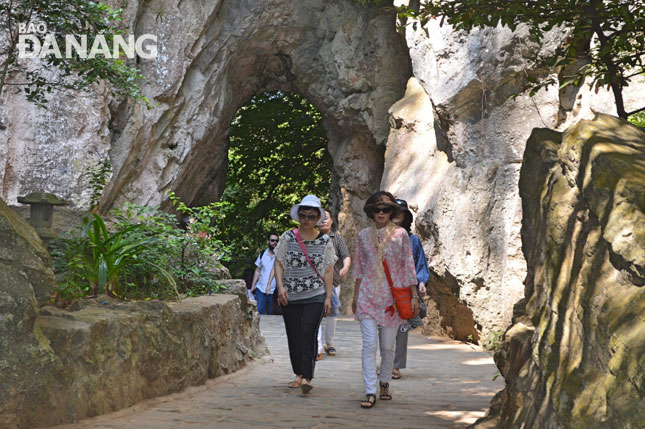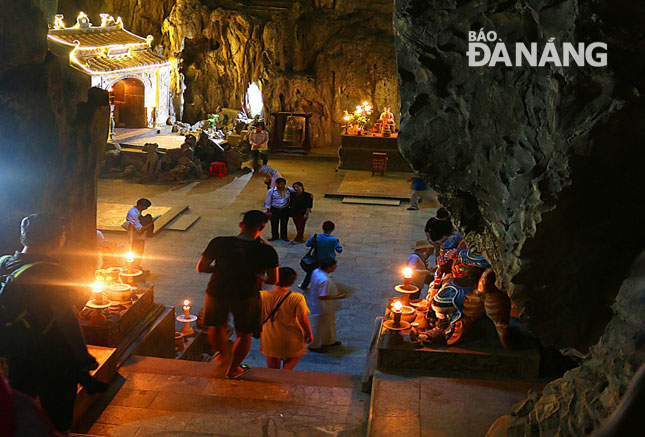Marble Mountains site shows off its special historical and cultural values
Showing off its special historical and cultural values, the Marble Mountains Tourist Area in Hoa Hai Ward, Ngu Hanh Son District, Da Nang has been recognised as a national special relic site by the Ministry of Culture, Sports, and Tourism.
 |
| The Marble Mountains site welcomes thousands of visitors from both home and abroad each day |
The site was officially recognised as a national-level relic site by the Ministry of Culture, Sports and Tourism in 1980.
The Marble Mountains is a cluster of 5 marble and limestone mountains lying close to the sea, located about 10 km south of the city centre. Each mountain is named after one of the 5 elements in ancient oriental philosophy: metal, wood, water, fire, and earth.
A lot of the legends and folklore about the mountains have been spread through by word of mouth. Anyone visiting there is likely to come across someone - a child or a grey-haired person selling incense or souvenirs-who will gladly tell some of the stories about the mountains of which they are so proud. One local tale is that the mountains originate from egg shells.
Legend has it that a golden turtle came to the seashore and laid 5 eggs a long time ago. When the eggs hatched, their shells turned into the 5 mountains.
Each mountain is made of different coloured marble-there is pink marble in Water Mountain, white marble in Wood Mountain, red marble in Fire Mountain, water-coloured marble in Metal Mountain, and brown marble in Earth Mountain.
The colours change under different lighting conditions, and poets have compared the view to a beautiful girl contemplating the wind-swept East Sea.
Emperor Minh Mang made his imperial journeys to the Marble Mountains for 3 occasions in total during his reign.
In particular, Emperor Ming Mang named the venue “Ngu Hanh Son” in Vietnamese after the 5 elements, and added it to the cadastral map of Dai Nam, which was the name of Viet Nam over the 1838 - 1945 period.
With a dense concentration of pagodas, Buddha statues and other Buddhist cultural artifacts, the venue is one of the Buddhist hubs in Central Viet Nam.
 |
| The Marble Mountains scenic spot features a natural ecological region harmoniously intertwining with spiritual and cultural life. |
Regarding cultural values, the Marble Mountains are home to dozens of temples, pagodas, shrines, hundreds of precious artifacts showing off such beliefs of the Vietnamese, Chinese and even Cham people as Buddhism, Taoism, the Mother Goddess worship, and Brahmanism.
In terms of archaeological values, findings from previous excavations show that the Marble Mountains site is a residential area for the Cham people from the 7th to 11th centuries. Currently, the venue also preserves such many valuable Cham cultural artifacts as Dong Duong-style pedestals, Lingam-Yoni sculptures, and statues of Goddess Po Nagar.
Mr Nguyen Van Hien, the Head of Management Board of the Marble Mountains Tourist Area, said his agency has asked the municipal authorities to build a museum displaying exhibits related to this special national-level relic site, including traditional craft products handed down from generation to generation.
Also, it is also suggested that the remaining households on Huyen Tran Cong Chua Street should be displaced to resettlement areas to renovate the space surrounding Thuy Son Mount and carried out the 2nd stage of the upgrade of the Huyen Vi, Tam Thanh, and Quan The Am caves.
As a precious gift of nature endowed to the city, the Marble Mountains site is one of the most beautiful places in the central region, and truly a place not to be missed while you are in Da Nang.
Since the start of this year, this inviting site has welcomed about 1.9 million visitors, about 1.27 million of whom are foreigners, hereby contributing 81 billion VND to the State budget.